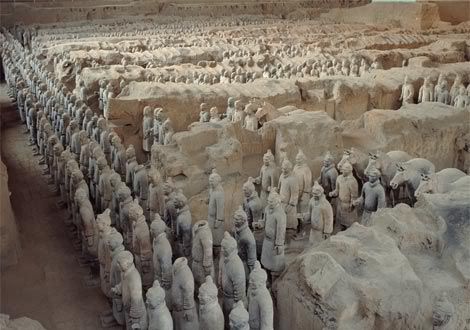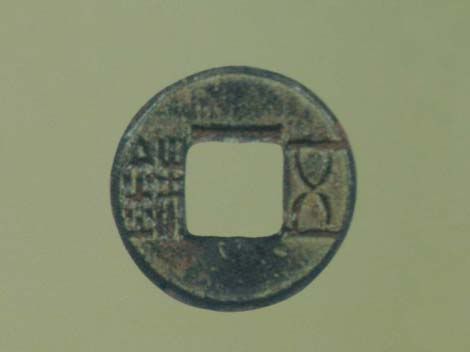The army was uncovered in 1974, in the province of Shaanxi. Some farmers were drilling a well east of Mount Lishan and hit something unexpected. I imagine their conversation as being something like:
“Hey. I hit something.”
“I see that.”
“Stop chewing that straw and help me here.”
“I object that you object to my chewing of straw. It’s good for my digestion.”
“Oh hell. Fine, damnit, chew your straw. Now help me over here.”
“Ok.”
[some digging]
“Shit and shit and more shit! There’s a whole army down here!”
“I guess we should tell Chairman Mao.”
“That’s a great idea. Let’s just walk into his office and let him know. Or would you prefer I send a telegram?”
“You’re so sardonic today.”
Archaeologists soon descended on the scene, and excavations began. What was found was that there were three massive pits of life-sized soldiers underneath an ancient tomb. In an effort to keep the tomb intact, the entire cavalcade has yet to be exhumed, though it’s estimated that there are 8000 soldiers, 130 chariots with 520 horses, and 150 cavalry horses all told.
Research tells us that the army was built at the dictate of Emperor Qin Shi Huang, who wished to take armed forces into the afterlife with him, to conquer that territory as he did Earth. If we look at this statement, and at China, we discover something interesting about the Chinese outlook.


(A) The Terra Cotta Army and (B) Qin China
The Chinese characters for China are 中国: literally, Middle Kingdom. Emperor Qin Shi Huang believed that, by conquering China, he hand conquered the entire earth. Simply by looking at the motives for the art’s existence, we learn something incredibly valuable about Chinese culture and their view of the world.
That they think of their land as the center of the earth shows a great reverence for the physical territory of China, and a spirituality (reflected by Buddhism, Confucianism, and Taoism) that grows from natural, eternal roots.
Now, we look more closely at the man for whom the army was built, Qin Shi Huang. To dig deeper, he was the first Emperor of Qin Dynasty. The Qin Dynasty (221 BCE – 206 BCE), as it turns out, was the first of its kind.
The Qin began as a state, during China’s warring states period. It quickly conquered its rival states and the remains of the Zhou Dynasty. Taking command of the competition, the Qin came to have undisputed control over all of China. Thus, the Qin were the first Dynasty to consolidate Chinese power, and as such, the precursor to the modern nation-state government.
In looking through history, we find that Chinese dynastic rule was not broken until 1912, meaning that China has been a country for over 2000 years. Indeed, China as a single unit, a group of like people living a unified existence, existed at a time when other Empires were either collections of states (Greece), or a central city-state and a series of conquered territories (the Persians, eventually the Romans, the Egyptians, etc).
What did the Qin Dynasty mean to China culturally? As the unifiers of the nation, they created a much larger work force than was previously available. This work force was responsible for various civic projects, the most important of which was the Great Wall, the only man-made object that can been seen from space.
The bureaucratic arm of the Qin standardized weights, measurements, language, and the writing system, and created a national currency; all of these things are integral to a fully operational and unified populace, tenets without which the modern nation-state would be an impossibility.


The Qin standardized Chinese currency and writing.
The Qin were also progressive in their use of the military as a branch of government, rather than the sole means of social control. The armed forces of the Qin used advanced weaponry and tactics to not only maintain control for their emperor and oligarchs, but also combat foreign and domestic enemies.
To the Qin's advantage, the dynasty’s military ignored accepted means of engagement at the time. Rather than waiting for their enemies to gather forces and ride to battle, they simply went out and crushed them at the most opportune moment. Though the Dynasty was short-lived, their marriage of military and bureaucracy would forever alter the course of Asian history.
The dominant philosophy of the Qin Dynasty was that of Legalism. Basically, Legalists believed, as their name implies, in the importance of laws. Their beliefs were simple: The law ought be written down and made public, and all citizens were henceforth subject to it.
Of course the philosophy goes much deeper than this (and of course, as history shows us, Chinese governments over the years have done anything but honor this philosophy), but the concept is integral in our understanding of the formation of unifying empires which went on to lord over much larger territories.
What we can see in this simple exercise is that art is very rarely, if ever, anything but art. It is, rather, an window into history, art, culture, society, and the ongoing trends of human civilization.


No comments:
Post a Comment